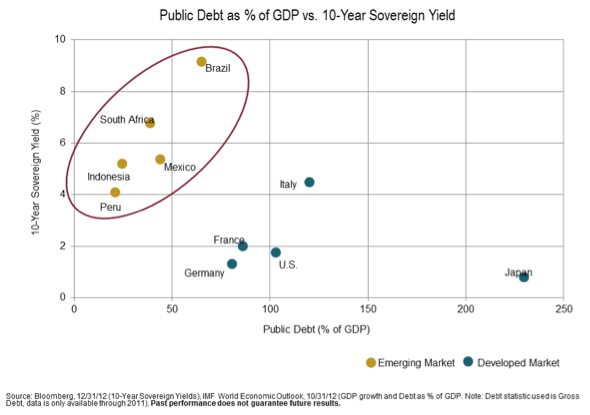Historically, investors have demanded higher compensation — usually in the form of higher yields — to lend to a high debt, low growth nation than they would a low debt, high growth one. But as the chart below shows, today’s global bond market reflects quite the opposite. The sovereign debt issued by many emerging market countries offers higher yields than the developed world, despite those emerging nations having progressively higher credit quality, better debt-to-GDP ratios and more favorable growth prospects than many countries in the developed world. Investors may be recalling the bad old days of runaway inflation and economic mismanagement in the emerging world. But many emerging countries have truly transformed into durable economies with real growth prospects and deficits that remain in check.
Better, Faster, Tighter
At OppenheimerFunds, we believe emerging market bonds as a category are generally poised to continue to benefit from better fiscal positions, faster growth and tighter monetary policy than their developed counterparts — all conditions that bode well for bonds denominated in emerging market currencies. Plus, there continue to be potential opportunities for higher yield in sovereign, quasi-sovereign and corporate debt in the developed world outside of the U.S. Exposure to fixed income and currency beyond our domestic borders may help unlock a greater opportunity set and diversify currency exposure.

Are Your 401(k) Clients Missing Out?
This opportunity may be largely unavailable to most 401(k) plan investors, whose fixed income menu is often limited to a stable value fund and a core bond fund. A fixed income portfolio allocated among these two popular fund options may lead to negative real returns — and a corresponding loss of wealth — for as long as the inflation rate exceeds high-quality bond yields.
Perhaps in recognition of the participant quest for real returns, 73% of plan sponsors now recognize global bonds as an appropriate non-core asset class. [1. Mercer U.S. Defined Contribution Investment Survey, August 2011.] Still, there seems to be a gap between this recognition and the implementation of global bonds in the plan. Advisors who counsel their 401(k) clients to offer exposure to the world’s fixed income opportunities — through an international bond fund with exposure to emerging markets — can offer meaningful potential for their participants to generate real income.
Mutual funds are subject to market risk and volatility. Shares may gain or lose value.
Foreign investments may be volatile and involve additional expenses and special risks, including currency fluctuations, foreign taxes and political and economic uncertainties. Emerging and developing market investments may be especially volatile. Fixed income investing entails credit risks and interest rate risks. When interest rates rise, bond prices generally fall, and a Fund’s share price can fall. Currency derivative investments may be particularly volatile and involve significant risks. Diversification does not guarantee profit or protect against loss.
These views represent the opinions of OppenheimerFunds, Inc. and are not intended as investment advice or to predict or depict performance of any investment. These views are as of the open of business on Jan. 24, 2013, and are subject to change based on subsequent developments.
Shares of Oppenheimer funds are not deposits or obligations of any bank, are not guaranteed by any bank, are not insured by the FDIC or any other agency, and involve investment risks, including the possible loss of the principal amount invested.
Before investing in any of the Oppenheimer funds, investors should carefully consider a fund’s investment objectives, risks, charges and expenses. Fund prospectuses and summary prospectuses contain this and other information about the funds, and may be obtained by visiting oppenheimerfunds.com or calling 1.800.255.2755. Investors should read prospectuses and summary prospectuses carefully before investing.
Oppenheimer funds are distributed by OppenheimerFunds Distributor, Inc. All rights reserved; used with permission.
RPL0000.102.0113

